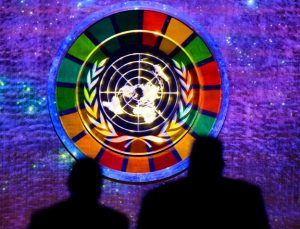
There will be no sustainable development without equality for all women and girls. It is no secret that the world is falling behind on the ambitions of the 2030 agenda and the promise of the SDGs. Geopolitical tensions are exacerbating the progress made on women’s rights—Deputy Secretary-General Amina Mohammed September 18.
By Shihana Mohamed
UNITED NATIONS, Sep 19 2023 – In 2015, the UN’s 193 member states adopted 17 goals for the health of the world that together comprise the Sustainable Development Goals (SDGs) to be reached worldwide by 2030.
The UN hosted a SDG Summit 2023 on September 18-19 to review progress toward those goals. Among the aims is to “achieve gender equality and empower all women and girls.” On this, progress is not going well.
As UN Secretary-General António Guterres warned in July, “Halfway to the 2030 deadline, the Sustainable Development Goals are dangerously off track. Gender equality is almost 300 years away.”
Among the furthest behind is the Asia-Pacific. Although a dynamic region, at this point the Asia-Pacific should have made half the progress needed to achieve the goals but its progress has reached only 14.4%.
According to the UN Women report on Women’s Leadership in Asia-Pacific, women’s representation in parliament is at 20% in the Asia-Pacific, below the global average of 25%. Women are underrepresented among chairs of permanent committees in charge of finance and human rights.
Women’s participation in peace negotiations — as negotiators, mediators and signatories — is notably rare. Women hold managerial positions at only 20%. This lack of progress exists at the UN as well.
The Asia-Pacific is home to around 4.3 billion people — 54% of the world population — and more than half of the world’s women. Yet only 18% of women are from the region among women in professional and higher categories of staff in UN organizations.
Among the professional staff in UN organizations, there is a visible disproportionate parity between the West and the rest of the world. Out of five regional groups of the UN member states — Western European and Other States, African States, Asia-Pacific States, Eastern European States, Latin American and Caribbean States — women from Western European and Other States, including North America, constitute just more than half of the population of professional women (51%) in the UN system.
Women from the Asia-Pacific constitute only 6% of senior or decision-making posts in UN organizations. The majority of these posts (about 53%) are held by staff from Western European and Other States.
The recent review of racism in UN organizations by the Joint Inspection Unit, the UN’s external oversight body, confirmed that UN staff from countries of the Global South, where the population is predominantly people of color, tend to be in lower pay-grades and hold less authority than those from countries where the population is predominantly white or from the group of Western European and Other States. This racial discrimination in seniority and authority has emerged as a macro-structural issue to be addressed.
At the opening of the 61st session of the Commission on the Status of Women, the Secretary-General Guterres declared: “We need a cultural shift — in the world and our United Nations. Women everywhere should be recognized as equal and promoted on that basis. We need more than goals; we need action, targets and benchmarks to measure what we do. But for the United Nations, gender equality is not only a matter of staffing. It relates to everything we do.”
If the UN is serious about definitive advancement in the status of women, its organizations should focus exclusively on necessary measures to increase the representation of women from Asia-Pacific countries.
These measures should include, but not be limited to, establishing targets for balanced regional diversity in UN organizations, ensuring recruitment and selection assessments are free from biases, and conducting audits of Asia-Pacific women’s career progression to identify and eliminate barriers. It is equally essential to ensure that women from the region are placed in decision-making positions.
UN organizations must faithfully reflect the diversity and dynamism of staff from all countries and regions of the world, including at senior and decision-making levels. This aspect is critical if the organizations are to implement mandates to help deliver the Sustainable Development Goals by 2030.
At the event organized by the UN Asia Network for Diversity & Inclusion to commemorate the 77th UN Day, Ambassador Anwarul Chowdhury, former Permanent Representative of Bangladesh to the UN and former UN Under Secretary-General, noted that the UN Charter “is the first international agreement to affirm the principle of equality between women and men, with explicit references in Article 8 asserting the unrestricted eligibility of both men and women to participate in various organs of the UN.”
“It would therefore be most essential for the UN to ensure equality, inclusion and diversity in its staffing pattern in a real and meaningful sense,” he said.
“Leave no one behind” is the central, transformative promise of the Agenda for Sustainable Development and its Sustainable Development Goals adopted eight years ago. Fulfilling this promise for all women and girls requires addressing the rights, needs and concerns of marginalized groups.
Leaders of UN organizations need to ensure that they meet their goals at home and in their own organizations, while calling for their achievement worldwide.
Shihana Mohamed is one of the Coordinators of the United Nations Asia Network for Diversity and Inclusion (UN-ANDI) and a Public Voices Fellow with The OpEd Project and Equality Now.
IPS UN Bureau